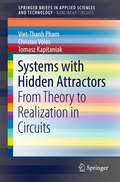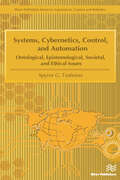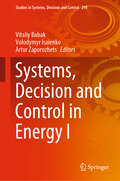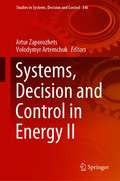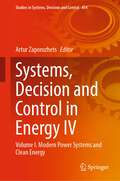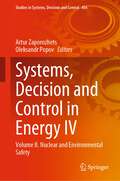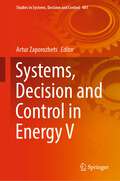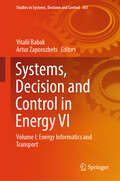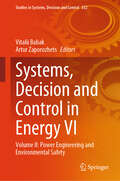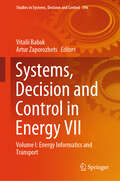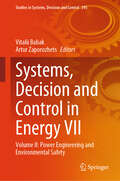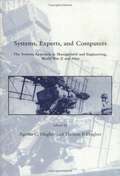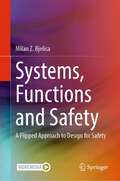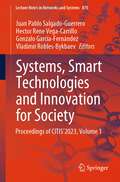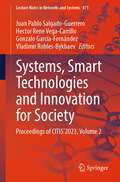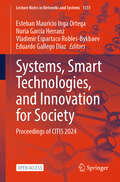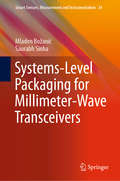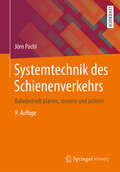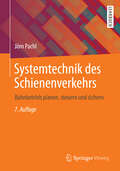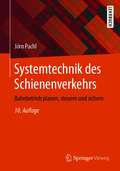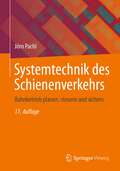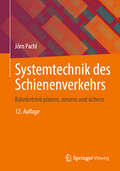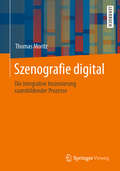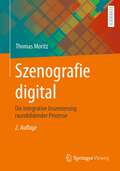- Table View
- List View
Systems with Hidden Attractors
by Christos Volos Viet-Thanh Pham Tomasz KapitaniakThis brief provides a general overview of nonlinear systems that exhibit hidden-attractor behavior, a topic of interest in subjects as divers as physics, mechanics, electronics and secure communications. The brief is intended for readers who want to understand the concepts of the hidden attractor and hidden-attractor systems and to implement such systems experimentally using common electronic components. Emergent topics in circuit implementation of systems with hidden attractors are included. The brief serves as an up-to-date reference on an important research topic for undergraduate/graduate students, laboratory researchers and lecturers in various areas of engineering and physics.
Systems, Cybernetics, Control, and Automation
by Spyros G. TzafestasSystems, cybernetics, control, and automation (SCCA)are four interrelated and overlapping scientific and technological fields that have contributed substantially to the development, growth, and progress of human society. A large number of models, methods, and tools were developed that assure high efficiency of SCCA applied to practical situations. The real-life applications of SCCA encompass a wide range of man-made or biological systems, including transportations, power generation, chemical industry, robotics, manufacturing, cybernetics organisms (cyborgs), aviation, economic systems, enterprise, systems, medical/health systems, environmental applications, and so on. The SCCA fields exhibit strong influences on society and rise, during their use and application, many ethical concerns and dilemmas. This book provides a consolidated and concise overview of SCCA, in a single volume for the first time, focusing on ontological, epistemological, social impact, ethical, and general philosophical issues. It is appropriate for use in engineering courses as a convenient tutorial source providing fundamental conceptual and educational material on these issues, or for independent reading by students and scientists.Included in the book is:• Background material on philosophy and systems theory• Major ontological, epistemological, societal and ethical/philosophical aspects of the four fields that are considered in the book• Over 400 references and a list of 130 additional books in the relevant fields • Over 100 colored photos and 70 line figures that illustrate the text
Systems, Decision and Control in Energy I (Studies in Systems, Decision and Control #298)
by Vitaliy Babak Volodymyr Isaienko Artur ZaporozhetsThis book examines the problems in the field of energy and related areas (including chemistry, transport, aerospace, construction, metallurgy and engineering) that Ukrainian scientists are currently investigating. The research presented focuses on ensuring the operational reliability, durability and safety of energy equipment, as well as the development of control, diagnostics and monitoring systems in the energy sector. Further, the book explores the ecological consequences of energy facilities , particularly environmental pollution in large cities and industrial areas. Written mainly by representatives of the Council of Young Scientists of the Department of Physical and Technical Problems of Energy at the NAS of Ukraine, it is intended for researchers and engineers, as well as lecturers and postgraduates at higher education institutions interested in the control, diagnosis and monitoring of energy facilities.
Systems, Decision and Control in Energy II (Studies in Systems, Decision and Control #346)
by Artur Zaporozhets Volodymyr ArtemchukThis book examines the problems in the field of energy and related fields (chemical, transport, aerospace, construction, metallurgy, engineering, etc.) and consists of 4 subsections: Electrical Engineering, Heat Power Engineering, Cybersecurity and Computer Science & Environmental Safety. In the first section, authors pay attention to contemporary issues related to the development of the electric power industry, electrical engineering, the physics of electrical phenomena and renewable energy sources (such as solar energy and wind energy). The second section is devoted to modern problems in heat power engineering and considers modern means and methods that increase the efficiency and reliability of the functioning of heat power facilities. The third section is devoted to issues of cybersecurity of critical facilities, in particular energy facilities, as well as the development of computer science and the introduction of modern information and measurement systems in the energy sector. The fourth subsection deals with the problems of rational use of natural resources, accounting for emissions of harmful substances, environmental issues at energy facilities, as well as the development of a methodology for environmental safety. The book includes 21 chapters. A book is for researchers, engineers, as well as lecturers and postgraduates of higher education institutions dealing with issues of control, diagnosis and monitoring of energy facilities.
Systems, Decision and Control in Energy III (Studies in Systems, Decision and Control #399)
by Artur ZaporozhetsThis book describes new energy saving methods and technologies for heat power engineering. The book is devoted to topical issues of energy and related industries. Leading Ukrainian scientists from both scientific institutes and educational universities took part in its creation. The research results are presented in 6 parts: electrical engineering, heat power engineering, nuclear power engineering, fossil fuels, cybersecurity and computer science, environmental safety. Results of regulating of operating modes and applicability of model checking technique in power systems are showed. Separate block of questions regarding the functioning of nuclear power plants, their waste and preventive measures of protection against negative effects on living organisms (including, for example, the Chernobyl nuclear power plant) is considered. The results of the peculiarities of the extraction, purification and use of fossil fuels are presented. In some chapters, presented the results on improving the cybersecurity of energy systems and its resilience to various threats, including the use of 5G technology. Traditionally for this series, issues of ecological safety, the impact of different energy systems on the environment and its protection are considered. A book is for researchers, engineers, as well as lecturers and postgraduates of higher education institutions dealing with energy sector, power systems, ecological safety, etc.
Systems, Decision and Control in Energy IV: Volume I. Modern Power Systems and Clean Energy (Studies in Systems, Decision and Control #454)
by Artur ZaporozhetsThe concept of "energy" includes methods for obtaining and using various types of energy for the needs of human society. Energy is one of the foundations for the development of modern society. The effectiveness of solving social, economic and technical problems, as well as the anthropogenic transformations of nature, is largely determined by energy production and the scale of energy production.Modern energy is not a separate industry, but it penetrates widely into other areas, in particular, chemical, transport, aerospace, construction, metallurgy, engineering, agriculture, etc. The energy sector is based on complex technical systems that are multicomponent, spatially distributed systems that during their operation are affected to a wide range of design and non-design thermomechanical loading conditions, the effects of aggressive fields and units, unauthorized influences (operator errors, terrorism, sabotage) and can reach various limit states.Complex technical systems are characterized by complex non-linear interactions between their constituent elements, complex chains (scenarios) of cause-effect relationships between hazardous, probabilistic events and processes that occur during their life. These scenarios can be implemented over complex ramified scenario trees.Ensuring the operational reliability, durability and safety of power equipment is a difficult task, which is associated with the organization of the reliability of control over the operation of power plants and ensuring optimal conditions for their operation. In this regard, we can distinguish a whole class of tasks related to the development of control systems, diagnostics and monitoring in the energy industry, which are presented in this book. Of particular relevance now is the use of UAVs in the energy sector.Particular attention must be paid to the environmental consequences of the operation of energy facilities, the main of which is significant environmental pollution in large cities and industrial areas.The development of environmental management information systems is the prerogative of the state, corporations and one of the main directions of the national informatization policy. A clearly debugged system of environmental monitoring gives a general idea of the features of the current ecological state, the main directions of state policy in the field of environmental protection, the use of natural resources and environmental safety. The methodology and hardware-software tools for monitoring the state of the environment presented in the monograph are effective tools for supporting decision-making in managing the environmental safety of the atmosphere during its technogenic pollution.
Systems, Decision and Control in Energy IV: Volume IІ. Nuclear and Environmental Safety (Studies in Systems, Decision and Control #456)
by Artur Zaporozhets Oleksandr PopovIn recent years, the scale of environmental hazards has been growing, emergencies occur more often at special facilities, in particular nuclear power, the largest of which was the accident at the Chernobyl nuclear power plant in Ukraine on April 26, 1986. With the advent of nuclear power, it was believed that nuclear power reactors were safe enough, control and monitoring systems, protective screens and trained personnel would guarantee their trouble-free operation. There is also a trend now that nuclear power is "environmentally friendly" because it provides a reduction in greenhouse gas emissions with replacing power plants working on fossil fuels. Some countries, such as the United States, have recently classified nuclear energy as a renewable energy source. Despite this, nuclear power is potentially dangerous due to: - possible accidents at power plants, accompanied by the ejection of radioactive materials into the environment; - ejections of about 250 radioactive isotopes into the environment as a result of the operation of nuclear reactors; - emissions of 85Kr, which changes the electrical conductivity of the atmosphere. This gas behaves like a greenhouse gas in the atmosphere, thereby contributing to anthropogenic climate change on Earth; - pollution of the biosphere with plutonium; - radioactive waste is the most important cause of environmental hazard, which remains unresolved. Civilian nuclear power reactors operating throughout the world annually generate large amounts of low-, medium- and high-level radioactive waste. Radioactive pollution accompanies all parts of the complex production of nuclear energy: the extraction and processing of uranium, the operation of nuclear power plants, the storage and regeneration of fuel, which has a significant impact on the environmental friendliness of nuclear energy. In addition, up to 300 natural and technogenic emergencies are registered annually, as a result of which people die and great economic damage is caused. The main reasons for the occurrence of technogenic accidents and catastrophes and the strengthening of the negative impact due to the occurrence of natural and technogenic emergencies in Ukraine are: obsolete fixed assets, in particular for environmental purposes; large volume of transportation, storage and use of hazardous substances; the emergency state of a significant part of public utility networks; insufficient investment support for the process of introducing the latest resource-saving and environmentally friendly technologies in environmentally hazardous industries, primarily in the metallurgical, chemical, petrochemical and energy sectors; environmental problems associated with significant changes in the state of the geological and hydrogeological environment and caused by the closure of unprofitable mining enterprises and mines; unwillingness of economic subjects to take measures to prevent accidents and catastrophes at high-risk and potentially hazardous facilities.
Systems, Decision and Control in Energy V (Studies in Systems, Decision and Control #481)
by Artur ZaporozhetsThe book consists of 8 parts: Energy Informatics, Electric Power Engineering, Heat Power Engineering, Nuclear Power Engineering, Renewable Power Engineering, Fuels, Transport, and Environmental Safety. The results presented in this book are aimed at solving some of the technical issues proposed by the Ukraine Recovery Plan and other important scientific and applied problems in the field of energy. Scientists from leading Ukrainian academic institutions and universities are working on this book.This book is for scientists, researchers, engineers, as well as lecturers and postgraduates of higher education institutions dealing with energy sector, power systems, ecological safety, etc.
Systems, Decision and Control in Energy VI: Volume I: Energy Informatics and Transport (Studies in Systems, Decision and Control #561)
by Artur Zaporozhets Vitalii BabakIn an era marked by escalating energy demands and imperatives of environmental stewardship, this compendium serves as a comprehensive exploration of the multifaceted dimensions shaping contemporary energy development, with a focal lens on the symbiotic relationship between energy, information, and transportation systems. The canvas of 2023's energy evolution is painted against the backdrop of heightened consciousness surrounding climate change and environmental degradation. This epoch witnesses an unyielding momentum toward sustainability, catalyzed by a profound shift in energy-sourcing paradigms. Renewable energy sources—solar, wind, hydro, and beyond—attain unprecedented prominence, not merely as alternative energy options but as linchpins of a redefined energy matrix, fostered by advancements in technology, economics, and scalability. At the nexus of this transformative energy landscape lies the realm of Energy Informatics—a domain where information technologies converge with energy systems. Smart grids, IoT-enabled devices, data analytics, and artificial intelligence orchestrate a symphony of efficiency and optimization, revolutionizing energy management, demand-response dynamics, and grid resilience. The fusion of information technology and energy infrastructures stands poised to usher in an era of unprecedented interconnectivity and adaptability. Transportation, an indispensable facet of the energy ecosystem, undergoes a metamorphosis in 2023. Electrification, hydrogen-powered vehicles, and advancements in sustainable fuels reimagine mobility paradigms, heralding a transition toward greener, more efficient transportation systems. The synergy between energy and transportation, facilitated by data-driven insights and technological innovations, propels the convergence of these domains toward a more sustainable future. Moreover, the global socio-political landscape assumes paramount significance in shaping the contours of energy dynamics. Geopolitical considerations, international collaborations, and policy frameworks delineate the trajectory of energy infrastructure investments, trade patterns, and the realization of sustainable energy transitions on a global scale. Yet, within the narrative of progress, challenges persist. Legacy infrastructures, regulatory complexities, socio-economic disparities, and the imperative of inclusive transitions underscore the complexities inherent in reshaping the energy and transportation landscapes.
Systems, Decision and Control in Energy VI: Volume II: Power Engineering and Environmental Safety (Studies in Systems, Decision and Control #552)
by Artur Zaporozhets Vitalii BabakThis book presents the defining hallmark of 2023's energy panorama which lies in the resounding impetus toward sustainability—a seismic paradigm shift echoing across industries, policies, and societal aspirations. Heightened awareness of climate change, environmental degradation, and the imperatives of decarbonization propel an unprecedented surge toward renewable energy alternatives. Solar, wind, hydro, geothermal, and other sustainable modalities witness not only technological advancements but a transformative surge in accessibility, affordability, and scalability, redefining the global energy matrix. Within this transformative landscape, innovation emerges as the fulcrum catalyzing the metamorphosis of energy systems. Breakthroughs in energy storage technologies, smart grid optimization, and decentralized energy solutions orchestrate a symphony of efficiency, enabling the seamless integration of intermittent renewable sources while ensuring grid stability and resilience. The amalgamation of artificial intelligence, big data analytics, and energy systems heralds a new frontier of smart, adaptive energy networks, revolutionizing the paradigm of energy consumption and management. Furthermore, the geopolitical milieu assumes heightened significance in shaping the contours of global energy dynamics. Interwoven with alliances, trade dynamics, and international agreements, geopolitics exerts profound influences on energy security, infrastructural investments, and the trajectory of sustainable energy transitions. Collaborative endeavors and multilateral initiatives reverberate as essential instruments in navigating the complexities of a globally interconnected energy landscape. However, amid the triumphant strides toward a sustainable energy future, challenges persist. The intricacies of phasing out legacy infrastructures, addressing socio-economic disparities, navigating policy ambiguities, and fostering inclusive energy transitions underscore the labyrinthine complexities that necessitate astute navigation and multifaceted solutions.
Systems, Decision and Control in Energy VII: Volume I: Energy Informatics and Transport (Studies in Systems, Decision and Control #596)
by Artur Zaporozhets Vitalii BabakThis book presents a curated selection of contemporary research, capturing the progress of Ukrainian and international scientists in addressing the complex issues surrounding energy systems, sustainable fuels, and efficient transport solutions. The world&’s growing energy demands, coupled with pressing environmental concerns, present significant challenges and opportunities in the energy sector. The advancements within this sector are increasingly driven by innovations in technology, information systems, and cross-disciplinary research efforts. Through this collaborative scientific endeavor, the authors aim to offer a holistic view of current advancements and innovative solutions in three core areas: energy informatics, fuels, and transport. Energy informatics integrates data analytics, digital infrastructure, and real-time monitoring to improve energy efficiency and support sustainable energy transitions. The works presented in this section illustrate how the integration of cutting-edge computational models, artificial intelligence, and big data analytics is enabling smarter, more adaptive energy systems. Topics covered include optimization of energy consumption, predictive modeling for energy needs, and the development of robust frameworks to manage and process vast amounts of energy-related data. This section highlights how energy informatics serves as a foundational tool in meeting the evolving demands for efficient and sustainable energy. In the fuels section, the book addresses the urgent need for alternative and cleaner energy sources. The global push toward reducing greenhouse gas emissions and mitigating climate change impacts has accelerated research into innovative fuel sources. This section underscores the critical role of novel fuel technologies in ensuring energy security and reducing environmental impact. Transport, the third section, encompasses research on the transformation of the transport sector toward sustainability and efficiency. Transportation is a major consumer of energy and a significant source of emissions, making it a focal area in the transition to cleaner energy systems. This section presents a variety of studies on electric mobility and the development of low-emission technologies.
Systems, Decision and Control in Energy VII: Volume II: Power Engineering and Environmental Safety (Studies in Systems, Decision and Control #595)
by Artur Zaporozhets Vitalii BabakThis book explores the intricate interplay between burgeoning energy demands and the imperatives of ecological sustainability. The first section, Electric Power Engineering, explores critical innovations in the generation, transmission, and distribution of electric power. As global energy demands rise, the development of efficient and reliable electric power systems becomes essential. This section includes studies on optimizing grid performance, enhancing resilience, and integrating smart grid technologies. Advances in grid automation, energy storage, and demand response are examined, reflecting the shift toward adaptive, efficient, and secure power systems. The second section, Heat Power Engineering, addresses innovations in the generation and distribution of thermal energy. Heat power plays a vital role in industrial processes, residential heating, and energy-intensive applications, particularly in regions with cold climates. Researchers in this section present work on the optimization of heat transfer systems, combined heat and power (CHP) technologies, and efficient thermal energy storage solutions. The third section, Renewable Power Engineering, focuses on the development and integration of sustainable energy sources. Renewable energy technologies, such as wind, solar, hydro, and biomass, have become critical in reducing carbon emissions and achieving energy independence. The contributions in this section highlight advances in renewable energy production, storage, and integration with existing power systems. The final section, Environmental Safety, encompasses research on mitigating the environmental impact of energy production and consumption. With energy systems being one of the primary sources of emissions and pollution, environmental safety has become a central concern in energy research. This section presents studies on emission reduction technologies, pollution control strategies, and sustainable waste management practices within the energy sector. It includes research on air and water quality and sustainable resource utilization, highlighting how environmental safety measures can be incorporated into all stages of energy production and distribution.
Systems, Experts and Computers: The Systems Approach in Management and Engineering, World War II and After
by Agatha C. Hughes Thomas P. HughesAfter World War II, a systems approach to solving complex problems and managing complex systems came into vogue among engineers, scientists, and managers, fostered in part by the diffusion of digital computing power.
Systems, Functions and Safety: A Flipped Approach to Design for Safety
by Milan Z. BjelicaThis textbook provides up-to-date content in the fields of system engineering, system safety and functional safety, with up-to-date examples from the automotive, industrial and aerospace domains, with respect to the growing complexity of the field and the increased utilization of complex hardware and software in vehicle designs. The book covers practical functional safety insights concerning the required standards (e.g. IEC 61508, IEC 62061, ISO 13849, ISO 26262), but also inherent system safety process as a key factor towards the mitigation of systematic faults. Readers will be equipped with a broad understanding of safety and functional safety, with balanced theoretical and practical views in this area. The book covers the specific topics of introduction to system engineering, overall system safety and its relation to functional safety. Functional safety is introduced in all the required concepts, terminology and safety analysis methods. Basic fault-tolerance concepts are covered, including the design considerations to achieve functional safety. The book also gives an introduction to the required system safety processes and the applications of relevant functional safety standards.
Systems, Smart Technologies and Innovation for Society: Proceedings of CITIS´2023, Volume 1 (Lecture Notes in Networks and Systems #870)
by Juan Pablo Salgado-Guerrero Vladimir Robles-Bykbaev Hector Rene Vega-Carrillo Gonzalo García-FernándezThis book is dedicated to exploring the practical applications and future perspectives of intelligent technologies. It delves into various domains, including industry, mobility, telecommunications, and environmental considerations.The innovative nature of this text enables us to draw connections between technical advancements and experiences aimed at enhancing the integration of emerging technologies on local, national, and regional scales. It showcases the strides made in diverse engineering domains, underlining the book’s multidisciplinary appeal. This book is intended for a wide readership, catering to master's and doctoral students, professors, and researchers in the field of cutting-edge technologies. It also extends its relevance to businesses engaged in engineering development. The contents offer insights into novel methodologies, real-world case studies, and innovative techniques designed to optimize systems, ultimately contributing to societal progress.
Systems, Smart Technologies and Innovation for Society: Proceedings of CITIS’2023, Volume 2 (Lecture Notes in Networks and Systems #871)
by Juan Pablo Salgado-Guerrero Vladimir Robles-Bykbaev Hector Rene Vega-Carrillo Gonzalo García-FernándezThis book is dedicated to exploring the practical applications and future perspectives of intelligent technologies. It delves into various domains, including industry, mobility, telecommunications, and environmental considerations. The innovative nature of this text enables us to draw connections between technical advancements and experiences aimed at enhancing the integration of emerging technologies on local, national, and regional scales. It showcases the strides made in diverse engineering domains, underlining the book’s multidisciplinary appeal. This book is intended for a wide readership, catering to master's and doctoral students, professors, and researchers in the field of cutting-edge technologies. It also extends its relevance to businesses engaged in engineering development. The contents offer insights into novel methodologies, real-world case studies, and innovative techniques designed to optimize systems, ultimately contributing to societal progress.
Systems, Smart Technologies, and Innovation for Society: Proceedings of CITIS 2024 (Lecture Notes in Networks and Systems #1331)
by Esteban Mauricio Inga Ortega Nuria García Herranz Vladimir Espartaco Robles-Bykbaev Eduardo Gallego DiazThis open access book compiles the proceedings of the tenth edition of the International Congress on Science, Technology and Innovation for Society, a key event that addresses in a practical and multidisciplinary way smart technologies and their impact on crucial sectors such as sustainability, environment, information and telecommunications, industry and mobility. Through studies with diverse methodologies, basically applied research, it explores how emerging technologies such as artificial intelligence, machine learning, the Internet of Things and big data are transforming these fields, solving global problems and improving the quality of life. It should be noted that the novelty of the book lies in presenting research that integrates the perspectives of experts from different sectors, combining the technical vision with the analysis of the social, economic and environmental impacts of technological innovation. In this sense, it has a broad scope, as it is aimed at professionals, researchers and students of technology, engineering, data science, sustainability, etc., as well as entrepreneurs and public policy makers. It is also a valuable resource for those interested in understanding how emerging technologies can transform key sectors and contribute to a more sustainable future, from informed decision making in the fields of scientific research, technological innovation; as well as being a source of inspiration for entrepreneurs and project leaders seeking cutting-edge technological solutions. In short, a key work for those who wish to explore the future of smart technologies and their impact on society.
Systems-Level Packaging for Millimeter-Wave Transceivers (Smart Sensors, Measurement and Instrumentation #34)
by Saurabh Sinha Mladen BožanićThis book provides a system-level approach to making packaging decisions for millimeter-wave transceivers. In electronics, the packaging forms a bridge between the integrated circuit or individual device and the rest of the electronic system, encompassing all technologies between the two. To be able to make well-founded packaging decisions, researchers need to understand a broad range of aspects, including: concepts of transmission bands, antennas and propagation, integrated and discrete package substrates, materials and technologies, interconnects, passive and active components, as well as the advantages and disadvantages of various packages and packaging approaches, and package-level modeling and simulation. Packaging also needs to be considered in terms of system-level testing, as well as associated testing and production costs, and reducing costs. This peer-reviewed work contributes to the extant scholarly literature by addressing the aforementioned concepts and applying them to the context of the millimeter-wave regime and the unique opportunities that this transmission approach offers.
Systemtechnik des Schienenverkehrs: Bahnbetrieb Planen, Steuern Und Sichern
by Jörn PachlDieses Lehrbuch vermittelt sehr verständlich und anschaulich mit vielen Abbildungen das aktuelle Basiswissen der Eisenbahnbetriebslehre in Verbindung mit den betrieblichen Funktionalitäten der Leit- und Sicherungstechnik. Es beschreibt prozessorientiert die maßgebenden Systemeigenschaften des Schienenverkehrs. In der aktuellen Auflage wurden alle Kapitel zur Anpassung an den Stand der Technik aktualisiert. Praktische Zusatzinformationen zum Buch, wie beispielsweise ein Online-Glossar in Deutsch und Englisch, finden sich auf der Homepage des Autors.
Systemtechnik des Schienenverkehrs: Bahnbetrieb planen, steuern und sichern
by Jörn PachlDieses Lehrbuch vermittelt das aktuelle Basiswissen der Eisenbahnbetriebslehre in Verbindung mit den betrieblichen Funktionalitäten der Leit- und Sicherungstechnik. Es beschreibt prozessorientiert die maßgebenden Systemeigenschaften des Schienenverkehrs. Inhaltlich überarbeitet und erweitert wurden in der aktuellen Auflage die Ausführungen zu Gleisfreimeldeanlagen und zum European Train Control System. Neu aufgenommen wurde ein Abschnitt zum Leistungsverhalten von Rangierbahnhöfen. Praktische Zusatzinformationen zum Buch, wie beispielsweise ein Online-Glossar in Deutsch und Englisch, finden sich unter http://www.joernpachl.de/buch.htm.
Systemtechnik des Schienenverkehrs: Bahnbetrieb planen, steuern und sichern
by Jörn PachlDieses Lehrbuch vermittelt sehr verständlich und anschaulich mit vielen Abbildungen das aktuelle Basiswissen der Eisenbahnbetriebslehre in Verbindung mit den betrieblichen Funktionalitäten der Leit- und Sicherungstechnik. Es beschreibt prozessorientiert die maßgebenden Systemeigenschaften des Schienenverkehrs. Zur Berücksichtigung der zunehmenden Bedeutung des anzeigegeführten Betriebes und der digitalen Stellwerke wurden in der aktuellen Auflage insbesondere die Kapitel zur Fahrweg- und Zugfolgesicherung überarbeitet. Zudem wurden einige Begriffe an die heute bei der der Deutsche Bahn AG geltende Terminologie angepasst. Praktische Zusatzinformationen zum Buch, wie beispielsweise ein Online-Glossar in Deutsch und Englisch, finden sich auf der Homepage des Autors.
Systemtechnik des Schienenverkehrs: Bahnbetrieb planen, steuern und sichern
by Jörn PachlDieses Lehrbuch vermittelt sehr verständlich und anschaulich mit vielen Abbildungen das aktuelle Basiswissen der Eisenbahnbetriebslehre in Verbindung mit den betrieblichen Funktionalitäten der Leit- und Sicherungstechnik. Es beschreibt prozessorientiert die maßgebenden Systemeigenschaften des Schienenverkehrs. In der aktuellen Auflage wurden insbesondere die Abschnitte zum European Train Control System (ETCS) zur Berücksichtigung aktueller Entwicklungen überarbeitet und ergänzt. Weiterhin wurden in den Kapiteln zur Leistungsuntersuchung und zur Fahrplankonstruktion die Behandlung kapazitätsrelevanter Netzelemente sowie die Bewertung des Fahrplans in der Darstellung verbessert. Praktische Zusatzinformationen zum Buch, wie beispielsweise ein Online-Glossar in Deutsch und Englisch, finden sich auf der Homepage des Autors.
Systemtechnik des Schienenverkehrs: Bahnbetrieb planen, steuern und sichern
by Jörn PachlDieses Lehrbuch vermittelt sehr verständlich und anschaulich mit vielen Abbildungen das aktuelle Basiswissen der Eisenbahnbetriebslehre in Verbindung mit den betrieblichen Funktionalitäten der Leit- und Sicherungstechnik. Es beschreibt prozessorientiert die maßgebenden Systemeigenschaften des Schienenverkehrs. Überarbeitet wurden in der aktuellen Auflage insbesondere die Abschnitte zum European Train Control System und zur analytischen Leistungsuntersuchung. Praktische Zusatzinformationen zum Buch, wie beispielsweise ein Online-Glossar in Deutsch und Englisch, finden sich auf der Homepage des Autors.
Szenografie digital: Die integrative Inszenierung raumbildender Prozesse
by Thomas MoritzIm Buch wird im Kontext individueller Rezipientenpartizipation und Nutzerimmersion erläutert, welche Wahrnehmungsaspekte der performativen Raumbildung immanent sind und warum integratives Inszenieren sie effektiver macht. Integratives Inszenieren erweitert als Bestandteil der Screenografie interaktiv nutzbarer Informations- und Kommunikationssysteme das szenografische Berufsbild und ist für die systematische Entwicklung von grafischen Benutzeroberflächen im Systemischen Design essentiell.
Szenografie digital: Die integrative Inszenierung raumbildender Prozesse
by Thomas MoritzIm Buch wird im Kontext individueller Rezipientenpartizipation und Nutzerimmersion erläutert, welche Wahrnehmungsaspekte der performativen Raumbildung immanent sind und warum integratives Inszenieren sie effektiver macht. Integratives Inszenieren erweitert als Bestandteil der Screenografie interaktiv nutzbarer Informations- und Kommunikationssysteme das szenografische Berufsbild und ist für die systematische Entwicklung von grafischen Benutzeroberflächen im Systemischen Design essentiell.
